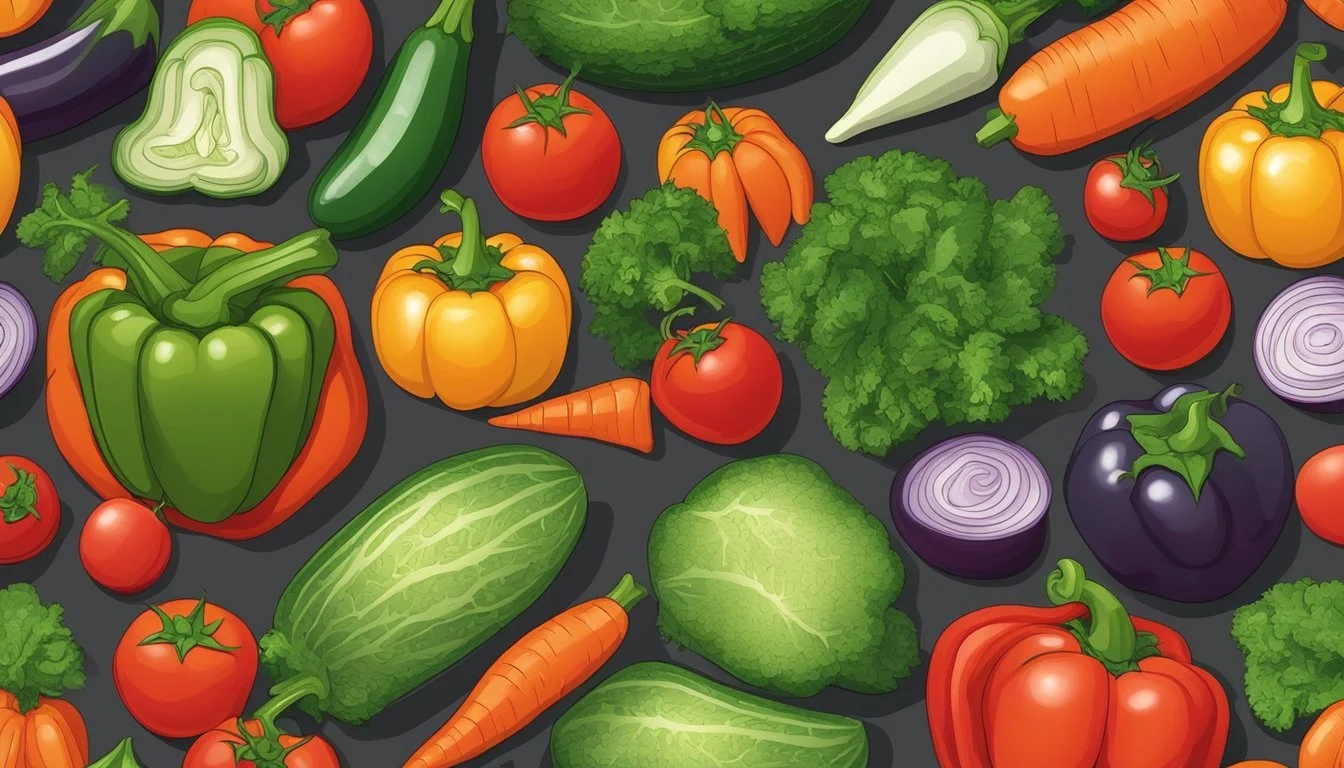Pepper, Bell Substitutes
Top Alternatives for Your Dishes
Bell peppers are a staple in many cuisines around the world, known for their vibrant colors—green, yellow, and red—and their sweet, almost fruity taste. They bring not only a pop of color but also a variety of health benefits to a range of dishes, from stir-fries to salads. However, there are occasions when bell peppers might not be available, or a different flavor profile is desired in a dish. In these instances, finding a suitable substitute that complements the other ingredients without compromising the integrity of the dish is essential.
A variety of substitutes exist that can mimic the texture or flavor of bell peppers to some extent. For instance, banana peppers provide a similar crunch with a slightly tart edge, whereas roasted red peppers offer a smoky sweetness that can replace red bell peppers quite effectively. When bell peppers are not an option, understanding the purpose they serve in a recipe—be it for sweetness, color, or texture—guides the selection of an appropriate alternative.
Choosing a bell pepper substitute also depends on the desired flavor intensity and the specific color needed. If the characteristic sweetness of bell peppers needs to be replicated without the slight bitterness that can sometimes accompany green bell peppers, one might consider incorporating mild sweet peppers or even trying chopped, roasted carrots for their sweetness and bright color. On the other hand, for those seeking to introduce a bit of heat while maintaining the crunch, sliced jalapeños, with their ribs and seeds removed to temper their spiciness, can be an excellent choice.
Bell Pepper Basics
Bell peppers are a versatile ingredient known for their thick walls and crunchy texture. They add not only a pop of color but also a nutritional punch to a variety of recipes.
Nutritional Value
Bell peppers are an excellent source of vitamin C, far surpassing the content found in citrus fruits. They also provide a good amount of antioxidants, which contribute to overall health. These nutrients are especially concentrated in the brightly colored red bell peppers.
Common Colors and Flavors
Bell peppers come in several colors including green, yellow, red, and orange. Green bell peppers have a slight grassy flavor, while the red, yellow, and orange varieties are sweeter and can have an earthy flavor. The red ones are the sweetest due to being fully ripened, offering a significantly different taste compared to the unripe green ones.
Cooking and Usage
Because of their crunchy texture and flavor profile, bell peppers are incredibly versatile in cooking. They can be used in salads, as toppings on pizza, and are frequently a key ingredient in fajitas, stir-fries, and stuffed pepper dishes. Bell peppers can be grilled, sautéed, or even enjoyed raw, adding crunch and color to any dish they grace.
Types of Bell Peppers
Green bell peppers: These are firmer with a slightly bitter, grassy flavor. They are less sweet than their counterparts because they are harvested before full ripeness.
Red bell peppers: These have the sweetest taste among bell peppers due to complete ripeness, which also makes them higher in vitamins and antioxidants.
Yellow and Orange bell peppers: These colors indicate a pepper that is more mature than green bell peppers but not as ripe as red ones, striking a balance with a mild and sweet flavor.
Bell peppers are an integral component across culinary traditions, appreciated for their distinct flavors and the bold visual appeal they lend to dishes.
Selecting Substitutes
When considering a bell pepper substitute, it is critical to evaluate how the replacement will affect the flavor, color, and texture of the dish to ensure the integrity of the final product is maintained.
Criteria for Replacement
When selecting a bell pepper substitute, one must consider several factors to best match the characteristics of the original ingredient:
Flavor: The substitute should complement or closely mimic the original bell pepper's flavor profile.
Color: The visual appeal is important; choose a substitute that provides a similar color if the dish's presentation is a priority.
Texture: A crunchy texture is often desired, especially in fresh preparations or where bell peppers are a key textural component.
Sweetness: Bell peppers have a natural sweetness, so replacements should have a comparable level of sweetness if that's an essential feature of the dish.
Pepper Substitutes Overview
Here's an overview of common bell pepper substitutes:
Sliced Eggplant: Can mimic the texture of bell peppers when cut into similar shapes and sizes.
Roasted Red Peppers: Offer a smoky flavor and can replicate the sweetness and soft texture of cooked bell peppers.
Celery: Provides a crunchy texture, suitable for salads or where robust crunch is needed.
Cubanelle Peppers: Mild and slightly sweet, these are an excellent alternative for maintaining similar flavor and crunch.
Substitutes by Dish
The best substitute can vary depending on the type of dish:
Pizza Topping and Casseroles: Roasted red peppers or banana peppers can provide the desired color and a complementary flavor.
Stuffed Bell Peppers: Smaller peppers such as poblanos or Anaheim peppers offer a suitable size and texture for stuffing.
Salads: Celery or thinly sliced jicama provide a crunch reminiscent of fresh bell peppers.
Substitutes by Cooking Process
Grilling: Eggplant and thick slices of onion hold up well to the heat and provide a satisfying texture.
Sautéing: Common substitutes like chopped carrots or celery maintain their structural integrity and offer a similar mouthfeel to sautéed bell peppers.
Specific Pepper Alternatives
Choosing a substitute for bell peppers depends on the desired flavor profile and heat level. Always consider how the substitute will interact with the other ingredients in your dish.
Mild to Medium Heat Peppers
Poblano Peppers: A versatile pepper with mild heat. When green, it adds a subtle kick without overwhelming dishes.
Anaheim Peppers: Similar to poblano in heat, but slightly sweeter, perfect for a bit more warmth.
Jalapeño: Brings a medium heat and is widely available; ideal for adding a spicy note.
Sweet and Mild Peppers
Cubanelle Peppers: These peppers are sweet with a slight tang, resembling a bell pepper’s taste but with a touch more character.
Banana Pepper: Banana peppers are milder and can add a similar crunch and sweetness to dishes.
Pimiento (or Pimento) Pepper: Known for its vibrant color and sweet flavor, it's a good substitute for bell pepper in recipes requiring a touch of sweetness.
Non-Pepper Vegetables
For those looking to avoid peppers entirely, consider:
Zucchini: With a mild flavor, it can mimic the texture of bell peppers in stir-fries and salads.
Mushrooms: Earthy and savory, mushrooms are a great alternative to bring depth to any dish.
Green Onion: Adds a slight bite and crispness, suitable for raw and cooked applications.
Eggplant: When sliced and marinated, it can take on a meaty texture that stands up to cooking and provides a pleasant mouthfeel in place of peppers.
Exotic and Less Common Substitutes
Italian Frying Peppers: Less common but a great substitute for cooking, these peppers offer a sweet taste similar to bell peppers.
Sichuan or Chinese Pepper: For a unique numbing sensation and an aromatic kick, be mindful of their intense flavor.
Pepperoncini: These are often pickled and can provide a tangy, mildly spicy alternative in salads and sandwiches.
FAQs About Bell Pepper Substitutes
When seeking a bell pepper substitute, it's important to consider how the alternative will impact the flavor, texture, and suitability for specific diets. Each substitute brings its own characteristics to a dish, which can be desirable or not, depending on the intended outcome.
Addressing Flavor Differences
When replacing bell peppers, one should account for the flavor profiles of potential substitutes. For instance, for sweet taste, pimento peppers can be used, while banana peppers can cater to those desiring a tangier edge. To add spiciness rather than sweetness, jalapeños may serve well, although their heat should be moderated depending on the dish. Substitutes like cubanelle peppers maintain a mild flavor while providing a hint of sweetness, making them a suitable option for dishes initially designed for green, red, yellow, or orange bell peppers.
Handling Texture Variations
The crunchy texture of bell peppers is a significant feature in many dishes. When looking for a similar crunch, green onions may be a suitable choice, though they bring a different flavor. For a soft texture, sliced eggplant presents an excellent alternative, absorbing flavors well during cooking. One must be mindful that texture changes can alter the overall mouthfeel and experience of a dish.
Considerations for Specific Diets
Individuals adhering to vegetarian or gluten-free diets often use bell peppers as a staple. Most bell pepper substitutes like cubanelle or jalapeño peppers naturally fit into these dietary considerations. However, when preparing a substitute for someone with sensitivities or indigestion issues, milder options are preferred. The majority of pepper substitutes are vegetable-based and hence suitable for vegetarian recipes, but the spice level should be tailored to avoid digestive discomfort.
Recipes and Applications
Utilizing bell pepper substitutes can lead to an assortment of delectable dishes, while keeping the integrity of the original recipe. The substitutes can play diverse roles in various recipes, from starring in fajitas and casseroles to enhancing salads and pizzas.
Substitute-Featured Recipes
Stuffed Bell Peppers: For a twist on the classic, stuff banana peppers with a hearty mixture of rice, chicken, and spices. Bake until tender, topping with cheese in the last few minutes for a melty texture.
Bell Pepper-Free Pizza: Top pizza with sliced eggplant as a bell pepper substitute. The eggplant offers a unique texture that complements traditional pizza toppings like mozzarella and tomato sauce.
Pepperless Fajitas: Sauté onions in lieu of green bell peppers alongside strips of chicken for a succulent fajita filling. Serve with warm tortillas and a squeeze of fresh lime juice.
Adjusting Recipes for Pepper Alternatives
Salads and Stir-fries: Replace bell peppers with Cubanelle peppers which are mild and sweet, seamlessly integrating into cold salads or quick-cooked stir-fries.
Sauteing and Grilling: When grilling or sauteing, pimento peppers maintain texture and impart a sweet flavor, making them a suitable alternative for red or yellow bell peppers.
Creative Cooking Tips
Enhancing Flavor Profiles: Experiment with Sichuan peppers for a bold spice in rice dishes, adding a layer of complexity that bell peppers typically don't provide.
Texture Considerations: For dishes where texture is crucial, such as stuffed peppers or casseroles, choose substitutes like jalapenos that have a similar structure to bell peppers but with an added spicy kick. Remember to remove seeds and ribs to control the heat level.





